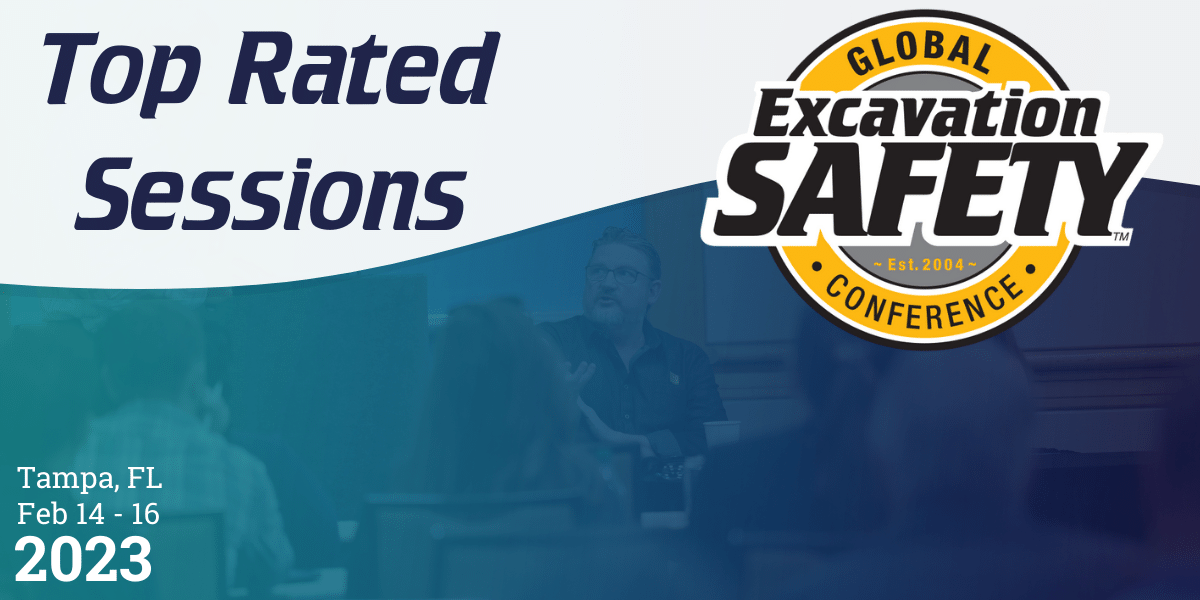
THE GLOBAL EXCAVATION SAFETY CONFERENCE is the place to gain knowledge about safe digging and the damage prevention industry. For the past 18+ years, we have remained focused on providing a variety of learning opportunities always pushing for new topics relating to new technologies and industry advancements, innovative solutions, and potential solutions that will resonate with our delegates.
Featuring the best sessions in the industry, our speakers remain focused on teaching you something you can bring back to your company to improve your processes and help keep people safe.
Below are the 2023 Conference Sessions who rated a minimum of 3.5 / 4*. (*Only sessions with a minimum of 10% return rate on voluntary surveys were ranked.)
Top Overall Session – Perfect Score Across the Board
Buried Alive: A Survivor’s Story
Joe Tantarelli, Trinity Safety Solutions
Joe recalled what started out as a typical day at work where he was laying pipe in a trench when suddenly his day turned out not so typical when the trench collapsed on him, and he had to be dug out and rushed to the hospital. This session covered why Joe took risks on the job even though he knew the hazards. He also explored how your state of mind contributes to making serious mistakes and delegates learned strategies to help workers avoid these types of incidents in the future.
Causes of Utility Damages in North Carolina: Direct Causes vs Root Causes
Dr. Ahmed Al-Bayati, Lawrence Technical University
Louis Panzer, North Carolina 811
How does NC811 categorize the cause of damages? What are the differences between direct causes and root causes? How do we identify the areas where attention will bring the most benefit? This session presented the immediate causes of damages in North Carolina. Delegates learned how they can leverage data in their state to help direct activities to reduce damages.
Contractors and PSMS
Steve Allen, Energy WorldNet
“Pipeline Operators are only as good as their worst contractors!” This session provided a brief background on PSMS and discussed the realities faced by both operators and contractors in today’s environment. This session also explored methods used by operators to engage contractors in their PSMS program and included a review of steps being taken by contractors to proactively address this important topic.
Damage Happens: What Comes Next?
Taylor Fudge, Claims Management Resources
Jonathon Musgrove, Claims Management Resources
Despite best efforts, accidents happen. It is inevitable underground assets will sustain damage at some point. An immediate response to these accidents and the information gathered are key to determining liability and resolving claims.
De-Escalating Volatile Situations in the Field
Jim Willis, In-Dev Tactical
Some handle verbal confrontations with ease, but for most, it’s difficult and unpleasant. Utility workers are no exception, and de-escalation is seldom the go-to response. Utility work tends to attract type-A personalities, so backing down is rarely the first instinct. The good news is de-escalation is a learned skill. Personnel who deal with the public learned proactive skills that allow them to understand when and how to engage, when to disengage, and when to escape the situation.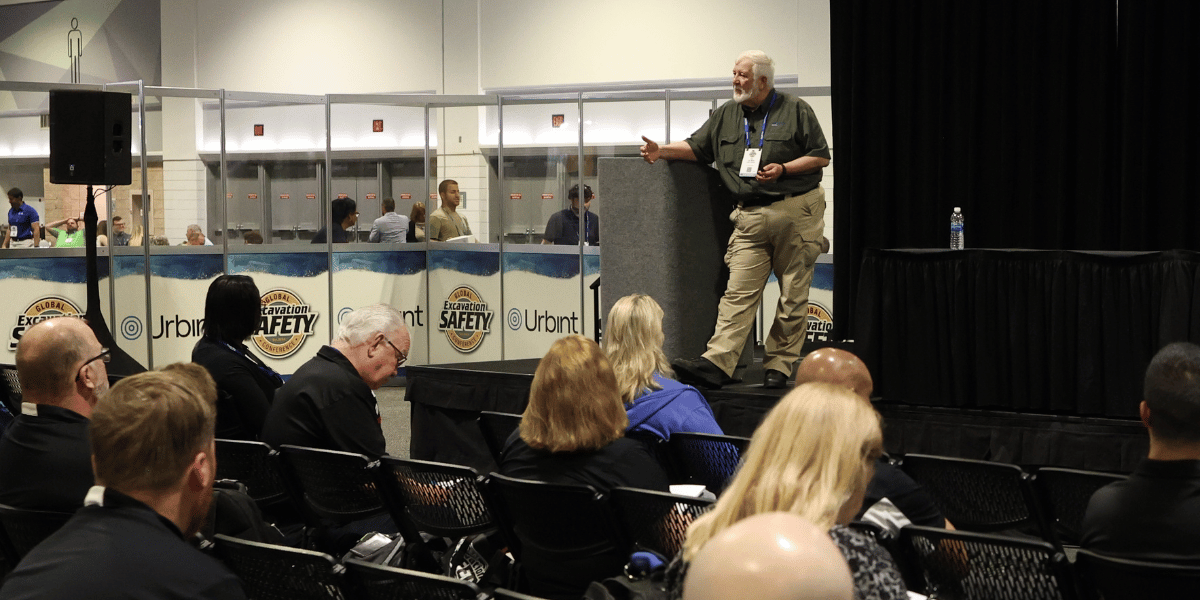
Electric Safety Summit: What Are the Best Practices for Preventing Damage to Electric Cables Above and Below Ground?
Moderator: Cliff Meidl, Cliff Meidl Enterprises
Panelists:
Glen “Cookie” Cook, Electrical Safety Consultant
Kelley Heinz, ComEd
Brandy Kitchel, Georgia Power
Lisa McKnight, City of Lawrenceville
Attendees joined this industry-focused summit with panel leaders discussing, “What are the best practices for preventing damage to electric cables above and below ground?”
ESA Town Hall Live: Are We at Peak Damage Prevention the Way it is Being Done? Are There Better Ways?
Moderator: Jemmie Wang, BizMetrix, LLC
Panelists:
Itzik Malka, 4M Analytics
Steve Mumm, GPRS
Duane Rodgers, PelicanCorp
Lindsay Sander, Sander Resources
It was shown that, using industry-wide damages data, increased spending by facility owners on damage prevention AS IT IS CURRENTLY BEING DONE almost certainly generates very negative ROIs. Beyond the current damage prevention paradigm, this session showed what new(er) methods and technologies are being used to increase the ROI on damage prevention spending?
Eyes Wide Open (EWO)
John Brix, Professional Speaker
Attendees learned how to set their new and young workers up for success. EWO discussed developing your training programs to allow maximum retention of information efficiently. EWO discussed the stress associated with being a new hire and integration process into a company’s culture. Attendees also learned how stress affects the body so you can self-identify issues as well as recognize stress related responses to those around you to help mitigate their long-term stress effects.
How Can a Good BBS Observation and Feedback Help with Damage Prevention
Joe Tantarelli, Trinity Safety Consulting
Mark Twain states in a letter, “The report of my death was an exaggeration.” So goes BBS (Behavior Based Safety) / Observation / Feedback. This session took a deeper dive into why some of these valuable BBS / Observation / Feedback processes die-off? The speaker shared steps that can help revive or build a useful BBS / Observation / Feedback process to improve Human Factors Management in, not only safety, but also another valuable asset, damage prevention.
How Will Next Technology Improve Locating Accuracy and Efficiency?
Moderator: Bob Nighswonger, Utility Training Academy
Panelists:
Pat Burk, Honeywell
Alan Haddy, UTTO
Matthew Wolf, ImpulseRadar USA, Inc.
This roundtable discussion covered the capabilities of current technology for both electromagnetic and GPR locating equipment, as well as what we can expect down the road. The panel also talked about what a locator’s wish list is for the future in order to make their job easier and even more precise. Another big topic of discussion was how new locate technology may shape the future.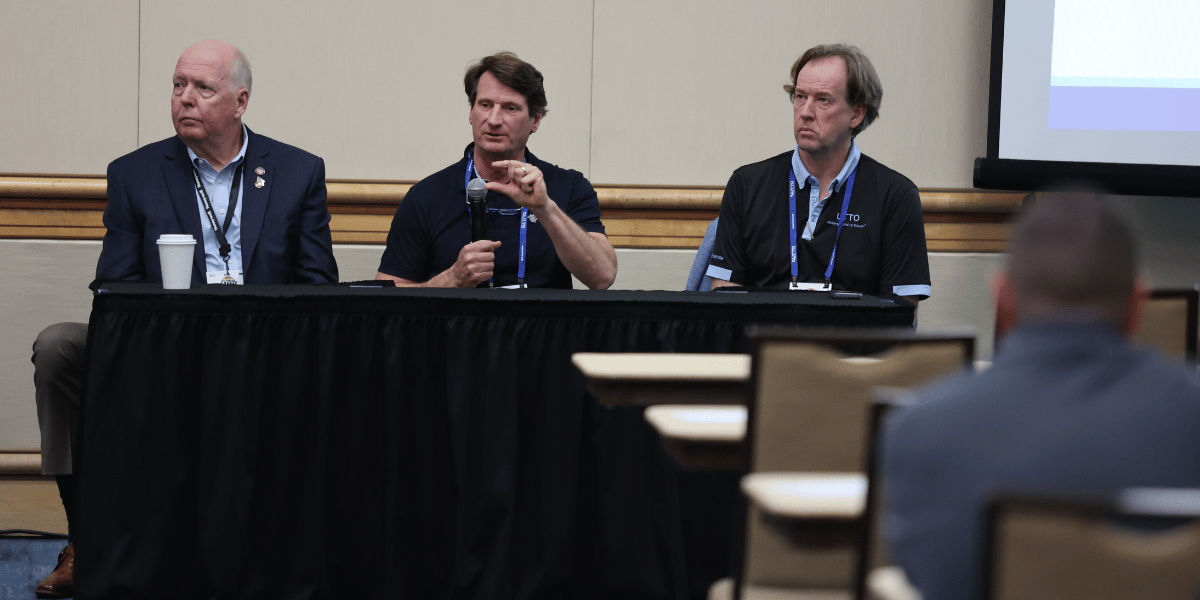
Improving Design Plans through Mobile Mapping
Michael Twohig, DGT Associates
This presentation highlighted a recent DGT project that required 61 miles of mapping throughout metro Boston, and how project planners and designers are using data to shape future design plans. Additionally, the session showcased data gathered from radar tomography and the benefits of mobile mapping technology.
Minnesota Projects for GPS Enabled Locating and a Process to View Facility Operator Maps
Travis Beran, Subsurface Solutions
Barbara Cederberg, Gopher State One Call
In August 2020, Minnesota began two projects addressing the need for higher quality utility maps and access to those maps by various stakeholders. Success will allow locators to help improve map quality by recording GPS data of a locate and transmit it back to the utility company. Stakeholders will also be able to access the utility maps within the one-call ticket excavation area via a web-based viewing process. This session discussed existing technology and issues that need to be addressed for industry adoption.
Natural Disasters and Damage Prevention – After the Disaster
Debbie Clyne, Canada Energy Regulator
Marie-Eve Latour, Canada Energy Regulator
Climate change has led to more extreme weather events. As we all know, these events can cause billions of dollars in property damage. For landowners, natural disasters are harrowing and can be really frightening when they impact their family, property, and livelihood. You can’t assume your damage prevention and public awareness activities take human behavioral factors into account. This session discussed some of the ways you can improve your damage prevention program to respond after the disaster.
Operational Efficiencies with Locate Management Software
Andy Hamilton, Grafton Technologies, Inc.
Chris Napoletano, Norfield
Grafton Technologies used to manage tickets processed by the 811 Center with an antiquated system of emails, paper maps, unorganized data, and pictures. They began a search to bring their locate management system into the 21st century. Their new software solution now provides operational efficiencies, time savings, and a web-based, modern digital experience. The team at Grafton Technologies shared their story of the process to find the right solution for their organization.
Overcoming Resistance to Change
Dr. Kathy Gruver, Professional Speaker
No one likes change, but it is a part of life. Delegates explored common reasons we are resistant to change. The speaker addressed the hidden reasons we want to stay unchanged and ways we can shift to a growth mindset and be more open and willing to inevitable changes in this life. This interactive presentation offered usable solutions to get your psyche ready to accept those changes in your life. Perhaps you’ll even start to instigate changes previously shied away from.
Part 1: Power Line Safety Initiative
Michelle Brannon, Power Line Safety Initiative
Stan Brannon, Power Line Safety Initiative
Michelle and Stan Brannon, a Manufacturing Engineer and Utility Accountant, shared their unimaginable experience when their son was electrocuted in a power line contact. They have since dedicated their careers and lives to power line safety awareness and safety. Their work in Texas has led to new laws for line inspection and maintenance, increased regulatory oversight, and utility partnerships for public education. Delegates learned how electric utilities can share their expertise and exert their influence to make power line public safety a priority.
Pipeline Safety Trust
Amanda McKay, Pipeline Safety Trust
The Pipeline Safety Trust promotes pipeline safety through education and advocacy, increased access to information, and partnership with residents, safety advocates, government, and industry, resulting in safer communities and a healthier environment. Excavation damage prevention is one of the many ways in which industry, regulators, and the public can work together to create safer communities.
RAS System
John Brix, Professional Speaker
What is your Reticular Activating System (RAS) and what if you are not using it properly? What if you are preventing yourself from being successful, happy, and innovative? Delegates learned how the RAS System works, how to align this filter with their desires, and how to become much more successful and productive. Tools were shared allowing delegates to start to reprogram their RAS System preventing valuable external data from being filtered out while preventing negative, less desirable information from accessing your subconscious mind.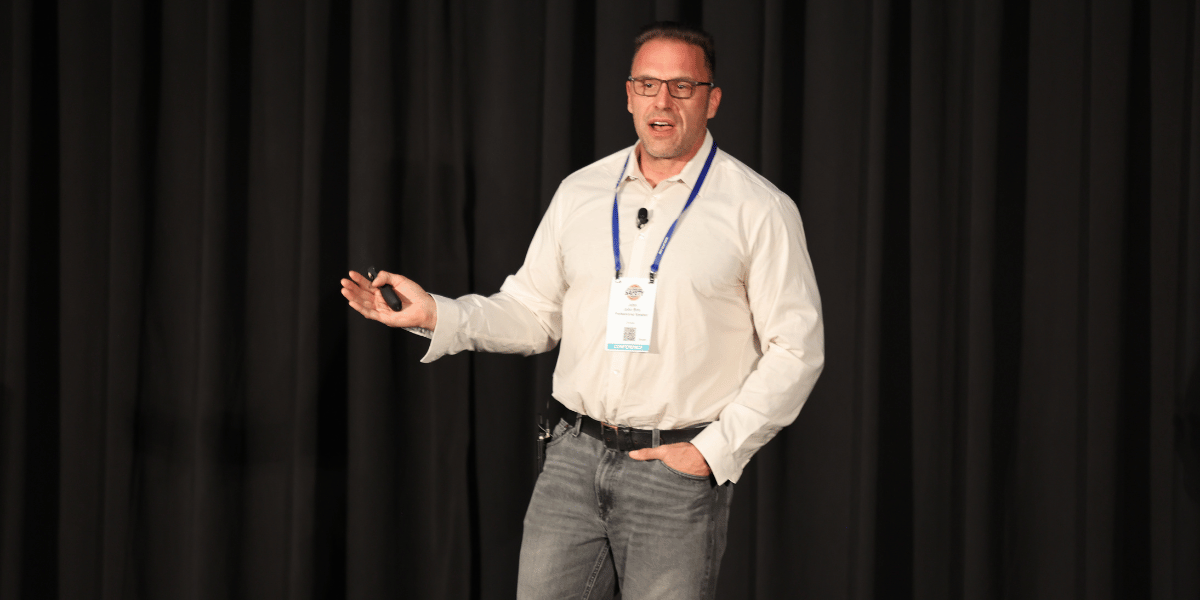
RP1162
Sam Minifie, API
In this session, delegates got an update on API RP1162, 3rd Edition. They learned how it has changed compared to the 1st Edition and what it means for operator public awareness programs.
State of Emergency: Cybersecurity Awareness
Sam Bloedow, Thriveon
Cybercrime is at an all-time high. How can you protect your business from an inevitable attack? Prevention starts with awareness and understanding of how an attack occurs. Whether your staff and data are centralized or remote and cloud-based, there are tried and true methods to protect your data and your business. Delegates learned more about the state of cybersecurity, anatomy of a cyberattack, basic security protections, and the business leader’s role.
Strategies to Consider for Reducing Update Tickets
Susan Bohl, OKIE811
Jerrell Welch, OKIE811
Are you seeing an increase in update rickets in your state? Are tickets being updated but there’s no excavation taking place? In Oklahoma, we’ve seen a major increase in update tickets and we’re receiving complaints from locators that no one is working at the remarked site. So, what can we do about it and why would we look at reducing ticket volume? This session focused on what we did, why we did it, and what other states are considering to help cut out what might be considered waste in the 811 system.
The Power of Safety First
Cliff Meidl, Cliff Meidl Enterprises
From electrical construction accident survivor to Olympian, Cliff Meidl’s dynamic story shares his incredible journey of resilience, vision, and perseverance. Hear his remarkable story of how he overcame a near-death electrical accident and the vital tools he used to move beyond obstacles. Cliff demonstrated how worksite accidents affect both our employees and families. He discussed the steps he believes are most important in creating a safety culture of excellence.
Two Confined Space Standards – Which one is for you?
Bruce Magee, United Rentals
Although OSHA’s construction industry-based confined space regulations were related in 2014, there is still confusion to which Standard should be followed. This session helped clarify misunderstandings between General Industry Standard, 1910.146, and Construction Industry Standard, 1926 Subpart AA. Keeping that in mind, the session addressed the importance of training your workers on the proper standard and provided ways to ensure everyone is compliant and safe.
Water & Sewer Infrastructure Protection Summit: Establishing Communication Between Locators and Excavators
Moderator: John Neilson, Waterworks District #1
Panelists:
Daniel Bigman, Bigman Geophysical
Robert Edwards, Citizens Energy Group
Jay Hemley, City of Tacoma
Rick Vincent, City of Tampa
Delegates joined this industry-focused summit with a panel of leaders discussing the importance of establishing communication between locators and excavators.
What Will They Say About You?
Wylie Davidson, Legacy Safety Solutions
This session explored the core values of how to effectively leave a lasting legacy, knowing the difference and setting the right course for you to succeed. Leaving a legacy is something we all have in common, good or bad, and it’s how we use the tools provided that allow us the ability to rise or fall.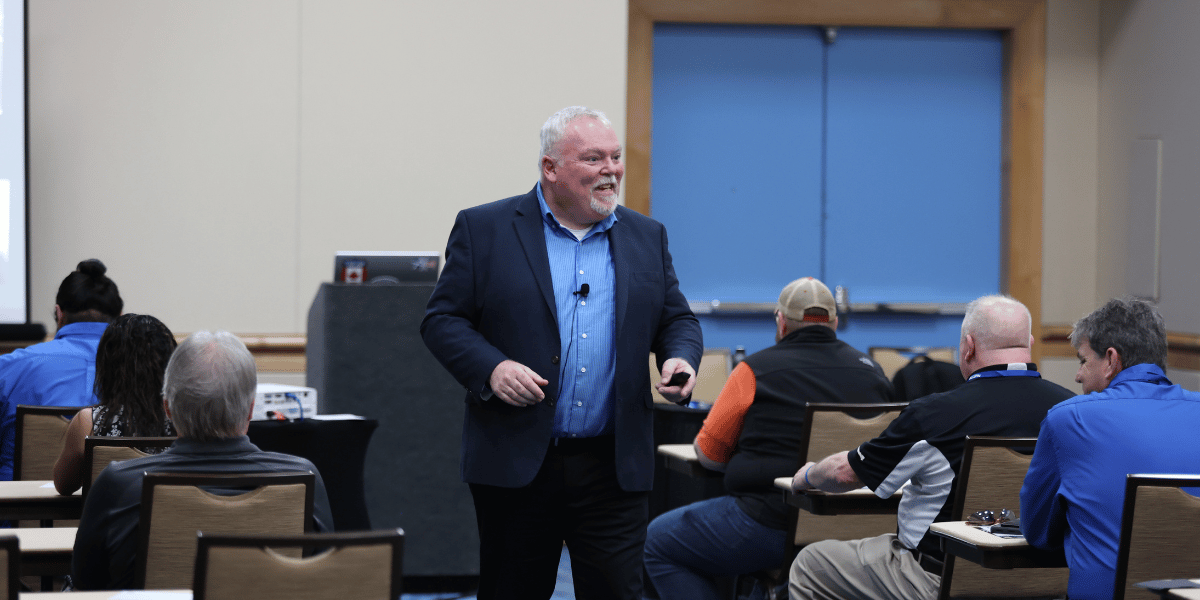
Workflows to Make GPR Useful in Damage Prevention
Daniel Bigman, Bigman Geophysical
This presentation focused on varied workflows available for completing projects successfully. Old techniques of locate and mark are not outdated, but part of the larger tool. Mapping integrations, vehicle deployed multi-channel systems, rapid data processing, and augmented reality can supplement older methods depending on project scopes. This session presented the variety of options available to professionals today and evaluate what workflows are appropriate for a given scope.
You the Jury: Trial of an Underground Utility Damage Claim
Anthony Jorgenson, Jorgenson PLLC
Rich Nelson, Zayo Communications
James Proszek, Hall Estill
Tammy Wilfong, Verizon
Question the witnesses, view the evidence, be the jury, and decide the case. Practicing trial attorneys and expert witnesses presented a trial based on an actual underground damage case. The audience participated by asking questions of the judge, the lawyers, and the witnesses before rendering a verdict based on the evidence, testimony, and arguments they heared during the trial.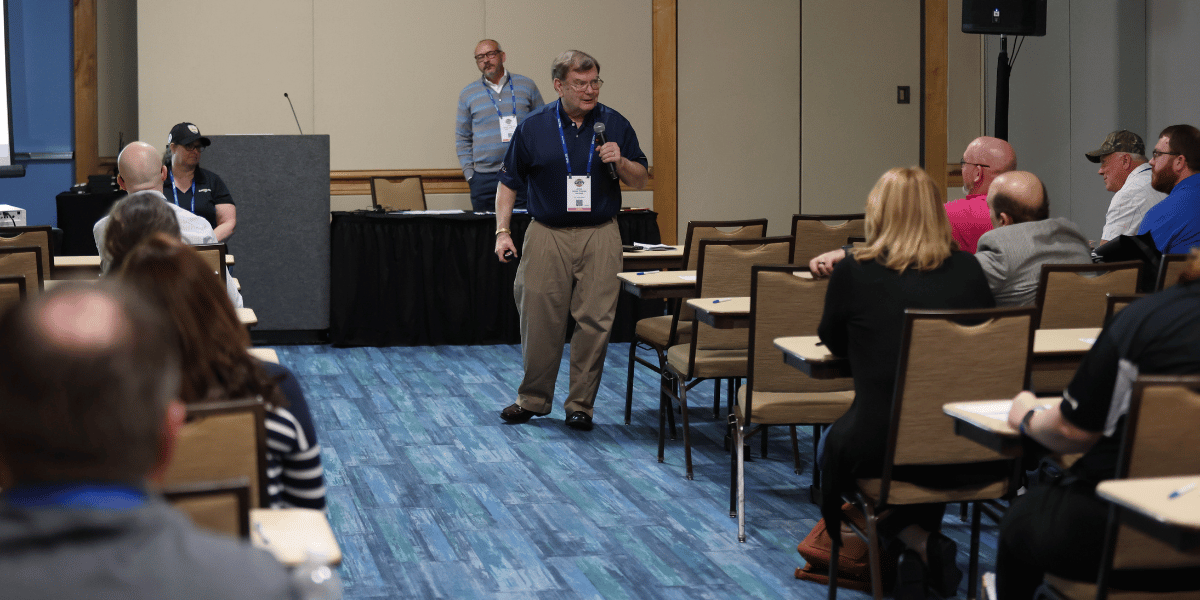
If these topics could help you increase your industry knowledge and advance your career, then you belong in New Orleans at the 2024 Global Excavation Safety Conference, March 19-21! With content addressing issues and concerns of the different facets of the industry, there is something for everyone.
Learn more at GlobalExcavationSafetyConference.com. Registration is OPEN!

![ESM Sidebar Ad[87] ESM Sidebar Ad[87]](https://excavationsafetyalliance.com/hubfs/ESM%20Sidebar%20Ad%5B87%5D.gif)



Comments